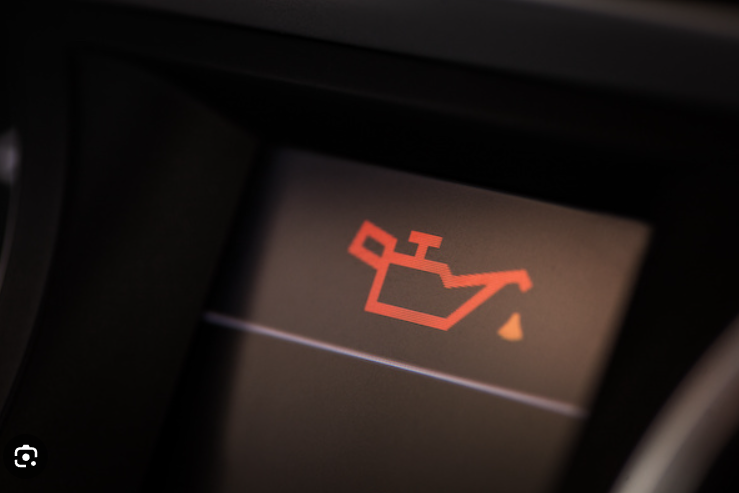When the oil light in your car turns on, it’s a clear sign that something is amiss under the hood. But what does it mean, and how long can you continue driving before it becomes a serious problem?
If you are experiencing a serious problem during a drive then you should search for ‘auto repair near me’ on maps and visit a shop with the most positive reviews.
This article delves into the reasons behind an oil light being on and provides solutions for addressing it promptly, whether it’s a quick fix or a more complex issue, to prevent engine damage.
Now, let’s jump in and keep your motor this machine running the best it possibly can!
Understanding the Importance of the Oil Light
When you notice your oil light has lit on the car dashboard, it usually shows that there is a possible problem with the level or pressure of your engine oil. Failure to comply with this warning can result in severe corrosion and consequent costly engine repairs. It is essential to mention here that the oil is critical for greasing engine parts, counter frictions and temperature regulation. Serious flaws may be identified in the process of the regular oil inspection, which help to fix the car’s problems and secure its future performance.
Common Reasons for the Oil Light to Turn On
Low Oil Level
It is especially true when the oil light on the dashboard indicates that there isn’t enough oil in your engine, which needs to lubricate all the parts. This is one of the most common reasons why your car’s oil light would go on.
There are several reasons why your engine’s oil level could be low, such as:
- Oil leaks
- Burning oil
- Lack of oil
- Lack of oil level
- Overheating
An overheated engine that has an insufficient supply of oil tends to consume too much heat and can devastate your vehicle. It is necessary to control the level of oil periodically and in case it needs to, add more so as to prevent engine complications.
Oil Pressure Issues
The oil light on a car’s engine means that there is an oil pressure problem that may be caused by the failure of the oil pump, clogging of the oil filter or other problems disrupting the flow of oil. One of the most common causes of oil pressure problems is, for instance, low oil levels as well as a faulty pump and a blocked filter that ultimately may result in severe damage to the engine. It is thus important that these results are anticipated ahead of time and dealt with sooner rather than later before possible damage to the engine.
Oil Filter Problems
When your car’s oil filter is not functioning well, it can enable the oil light to be on. This is because the primary role of an oil filter is to ensure that dirt and abrasives are eliminated from the engine oil. In case the oil filter becomes blocked or is damaged, it can prevent some oil from flowing and lead to reduced oil pressure and consequently an illumination of the oil light. Delaying the treatment of oil filter issues will cause damage to the engine through time which is why early detection is needed.
Faulty Oil Pressure Sensor
In the case of an automobile, if the oil pressure sensor from the engine is faulty, then it will lead to a switch on of the oil light even though there is no problem with the oil pressure. It is essential to carry out sensor replacement if there is one since it is crucial for accurate readings and avoid potential engine damage. This sensor is used to measure oil pressure if the engine is fitted with a dipstick.
Overheating Engine
The oil light will be on if the engine goes overheating. This results from heating of the engine and in which oil is unable to properly lubricate the moving parts. There can be many causes of overheating including leakage from coolant or mechanical error in the thermostat.
Worn Engine Components
An overworked engine with worn components and the internal combustion chamber that is left with insufficient greasing could also cause the oil light to turn on. However, machinations of the engine parts such as piston rings and valve seals wear out, they can cause leakages that let in oil into the combustion chamber. This results in oil burn and a loss of pressure responsible for the coming on of the oil light.
Electrical Issues
Sometimes, it is also due to electrical problems like bad connection or short circuit, that causes the oil light to turn on even though there is no true oil trouble on the engine. However, it is very important to properly diagnose and treat the electrical problems so that inconsequential repairs do not take place.
How Long Can You Run the Engine While the Oil Light is On?
The oil light warns about an oil pressure that is low that may cause unwanted engine damage. Driving with the oil light remains on may lead to disastrous consequences like overheated engine or complete engine failure. However, one should stop by the side of the road and check the oil level or call an emergency service if their oil light turns on while driving.
Preventive Measures to Avoid Oil Light Issues
- Check the oil level on your car to ensure that it is at a proper level.
- In order to make your oil clean and fresh, follow the recommended oil changing schedule.
- Use high-quality oil filters for removing impurities from the engine and capturing them.
- Do not overtax or overwork your car as this may cause the increase in oil consumption.
- Monitor the oil pressure gauge to look for any unforeseen drops in pressure that might point to an issue.
- Quickly fix any leaks to stop oil spilling out and reducing oil levels.
Conclusion
Finally, if your oil light is on, this needs to be dealt with immediately. Ignoring the warning in response may lead to serious damage to the engine. The fact that the oil light is on means low oil pressure and thus should not make the driver drive long. It is recommended that you take the car to a repair shop where someone will know how it happened and what steps could be taken to remediate it.

